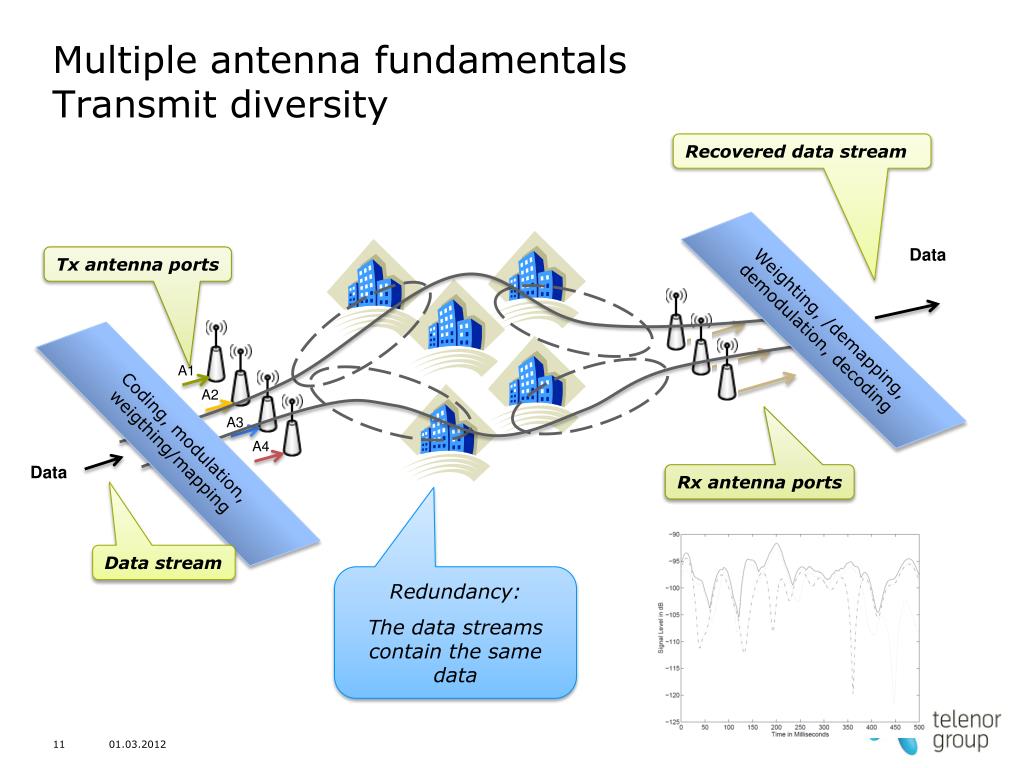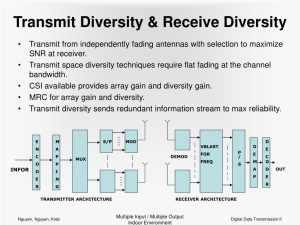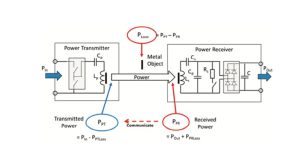

The intricacies of wireless communication are far from simple, but two concepts stand out as particularly vital: transmit and receive diversity. These techniques work in tandem to bolster signal quality, with the former sending signals and the latter receiving them. The importance of these components cannot be overstated – their combined efforts are essential for ensuring that signals reach their intended destination without interference.

Unfortunately, there are many factors that can impact transmission. Multipath effects, which occur when a signal bounces off objects and creates multiple paths to the receiver, can lead to interference and reduced signal quality. To combat this issue head-on, transmit diversity comes into play by utilizing multiple antennas on the transmitter side to simultaneously send different versions of the same signal.
But even with transmit diversity in place, there may still be issues affecting reception on the other end. This is where receive diversity shines; using multiple antennas on the receiver side allows for capturing different versions of transmitted signals so as to minimize or eliminate errors and interference during transmission. Especially helpful in scenarios where obstructions or environmental factors come into play during transmission.
By delving into both transmit and receive diversity techniques more deeply, we can better appreciate just how significant they are when it comes to overall wireless communication performance – whether it’s addressing multipath effects during transmission via transmitting antenna arrays or improving reception by reducing errors through diverse receivers – these methods help ensure reliable connectivity all around!
The realm of wireless communication is a perplexing one, involving the transmission of data through channels that are not physically connected. The process relies on transmitters and receivers to do their part in ensuring the quality of the signal is top-notch. However, this depends on a myriad of factors such as distance, obstacles, and interference from other sources.

To address these challenges head-on in wireless communication systems, transmit diversity presents itself as an effective solution. This approach involves sending multiple versions of the same signal via different antennas with hopes that at least one will reach the receiver without being distorted by multipath effects.
Conversely, receive diversity seeks to improve signal quality using several antennas at the receiving end. This strategy is particularly useful when dealing with signals affected by fading or interference from external sources. Multiple Input Multiple Output (MIMO) technology combines both transmit and receive diversity for even more exceptional performance levels in wireless communication systems. MIMO leverages multiple antennas at both ends simultaneously to send and receive data over separate streams without any nasty interference issues.
Further exploration into antenna design and optimization techniques can help clarify how these technologies integrate seamlessly into modern wireless communication systems while still achieving high-quality transmissions tailored towards diverse environments and applications without breaking your bank account!
The transmission of a signal through wireless communication is not as straightforward as one would think. Multipath propagation, for instance, complicates matters by allowing the signal to take several routes to reach the receiver. This results in varying amplitudes and phases at the receiving end due to reflection, diffraction, and scattering from different objects in the environment – talk about a head-scratcher!
Thankfully, technological advancements have made it possible to overcome such perplexities. Frequency diversity is one such technique where different frequencies are employed for transmitting data. Additionally, Multiple Input Multiple Output (MIMO) technology can be used to improve signal quality further.
With MIMO systems that use two transmitters and one antenna at each end of the link comes spatial diversity which decreases fading effects caused by multipath propagation while increasing bandwidth utilization without compromising high data rates – now that’s what I call burstiness!
In conclusion, analog techniques like frequency diversity coupled with digital methods such as MIMO technology do an excellent job in enhancing wireless communication performance despite environmental hurdles encountered along the way. By using these techniques together with various antenna configurations and modulation schemes based on real-time channel conditions measured in dB units during operation; achieving reliable high-speed connectivity over long distances even under challenging circumstances becomes viable!
The enigmatic concept of transmit diversity is a wireless communication technique that has revolutionized the quality of transmitted signals. Instead of relying on a single transmitting antenna, this technique employs multiple antennas to combat signal degradation caused by attenuation and shadow fading. By enabling multiple paths for the signal to travel along, it results in several copies arriving at the receiving antennas.
It’s no secret that radio frequency signals are subject to amplitude and phase variations due to various factors such as multipath effects caused by reflections from buildings and other obstacles. Transmit diversity comes into play here by sending out diverse versions of identical data on each antenna with varying amplitudes and phases. This cunning tactic ensures that even if interference or attenuation distorts some parts of the signal, there will still be enough information available at the receiving end for accurate channel estimation.
CDMA (Code Division Multiple Access) exemplifies how technology utilizes transmit diversity. In CDMA systems, each user’s data is modulated onto a unique code sequence before transmission so that it can be separated from other users’ data at the receiver end effectively. Transmit diversity works wonders in improving CDMA performance as it provides robustness against interference caused by other users’ transmissions on overlapping frequencies while simultaneously increasing downlink data rates since more bits per wavelength can be transmitted simultaneously over different paths.
In conclusion, Transmit Diversity may seem perplexing initially but has become an indispensable tool for modern wireless communication systems because it enables better coverage area without compromising quality reception while overcoming problems like attenuation or shadowing effect through its ability to send multiple copies via several transmitting antennas improving overall system performance significantly when applied correctly!
The enigmatic and convoluted concept of receive diversity is an essential technique in the realm of wireless communication, revered for its ability to enhance signal quality. The practice involves utilizing multiple antennas on the receiver side to alleviate the pernicious effects of fading channels and amplify coherence time. By harnessing this method, we can optimize performance concerning bit error rate (BER) and throughput.
Ratio combining stands as a common methodology in implementing receive diversity, where signals from distinct antennas are amalgamated with specific weights grounded on their power levels. Another tactic that has gained traction is maximum ratio combining, which takes both signal strength and phase information into account to refine reception quality. These sophisticated techniques empower us to decode modulated signals effortlessly even when they encounter Rayleigh fading.
In 5G networks, multiple input multiple output (MIMO) technology reigns supreme due to its capacity for providing both temporal and spatial diversity. MIMO utilizes several transmit and receive antennas concurrently, enabling efficient encoding or decoding of data streams while simultaneously mitigating interference stemming from other users or devices operating within the same frequency band. This breakthrough makes it feasible for UE’s located at a significant distance from base stations or experiencing weak signals to maintain dependable connectivity by virtue of MIMO technology bolstering signal quality.\n
The complexity of modern wireless communication systems demands the implementation of Multiple Input Single Output (MISO) technology. This ingenious approach utilizes multiple antennas at the transmitter and a single antenna at the receiver to enhance signal quality. But how does MISO achieve this feat?
One configuration involves using phase shifters to adjust the phase angle between signals transmitted from different antennas. The result is enhanced control over transmission, which mitigates deep fades caused by multi-path effects that would otherwise compromise signal strength.
Moreover, MISO technology increases transmission power without affecting interference levels by utilizing two antennas instead of one. This novel approach ensures reliable connectivity across vast distances while minimizing interruptions due to other devices in close proximity.
It goes without saying that MISO has revolutionized wireless communication systems’ performance capabilities. It remains an essential component in modern networks designed for high-speed data transfer and dependable connectivity across extensive areas.
Behold the marvel of Multiple Input Multiple Output (MIMO) technology, a wireless communication technique that harnesses the power of multiple antennas at both ends of the transmission. Witness as MIMO defies convention and transmits and receives multiple data streams simultaneously, elevating bit rate to new heights. This sorcery is accomplished through varying signal paths that reduce latency and bolster channel state information.
But how does this wizardry work? By exploiting multipath effects in wireless channels, MIMO captures signals from different signal paths with differing channel conditions using multiple antennas on either end. It’s like having eyes in all directions! Fading poses no threat as MIMO improves signal quality even in challenging scenarios such as urban areas or indoors.
Marvel not only at its magical abilities but also its dexterity in supporting wideband communications thanks to frequency diversity, which allows for better signal quality over wider ranges than traditional SISO systems. But wait, there’s more: spatial diversity adds yet another layer of performance enhancement by accommodating significant variations between different parts of a transmission path – now that’s what I call impressive!
The perplexing world of wireless communication demands the maintenance of signal quality in spite of pesky fading effects. Enter time and space diversity techniques, which offer a bursty solution to these challenges. One possible avenue involves the use of multiple antennas at either the transmitter or receiver end of a single input single output (SISO) system to boost signal energy reception.
But wait! There’s more. Another technique called frequency division multiplexing (FDM) utilizes multiple carriers with different polarization in cellular networks. This mind-boggling approach divides available bandwidth into smaller sub-bands so that each carrier can transmit data independently without interfering with other carriers – resulting in an increase in throughput and bitrate.
And if you thought things couldn’t get any more complex, think again! Multiple input multiple output (MIMO) technology capitalizes on spatial diversity by using numerous antennas at both ends of a wireless link to create statistically independent channels carrying unique information simultaneously. MIMO has skyrocketed in popularity because it provides higher spectral efficiency and better performance than SISO systems.
By combining time and space diversity techniques like MIMO, RF signals can be transmitted from various locations on one carrier frequency band without interference or degradation in signal quality – allowing for increased capacity and reliability while minimizing power consumption and hardware costs. Mind blown yet?
Time diversity, as a measure to counteract fading in wireless communication, involves transmitting the same signal multiple times with a calculated delay between each transmission. Its effectiveness has been proven through its application for years.
Space diversity can undoubtedly enhance signal quality by using several antennas to receive identical signals and then combining them for an overall improvement in reception.
Transmitting diversity pertains to using multiple antennas while sending out identical signals whereas receiving diversity focuses on employing more than one antenna during signal reception. The two methodologies are distinct but could prove complementary if combined efficiently.
Multipath, which ensues when numerous routes lead a single message towards the receiver simultaneously, can trigger interference resulting in subpar signal strength and reduced clarity.
MIMO (Multiple Input Multiple Output) technology employs many antennas both at the transmitter and receiver ends of data transfer channels to elevate data rates by improving connection quality significantly. It’s considered cutting-edge tech worldwide due to its far-reaching implications across various sectors.
MISO(Multiple Input Single Output) leverages several transmitters but only one receiver at its core functionality for enhanced connectivity and faster transmissions speeds-just like MIMO technology-but utilizing fewer components.
Through advanced techniques such as MIMO, time and space diversities can be combined to enhance signal strength and clarity. This amalgamation involves transmitting the same message multiple times with a calculated delay between each transmission while using various transmitters at both ends of data transfer channels.
You must be logged in to post a comment.